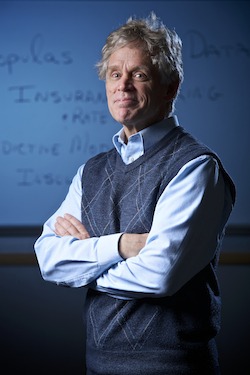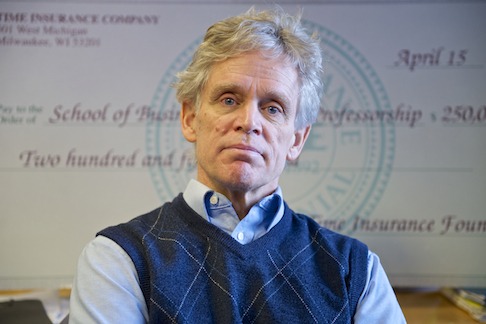The book is one of several department initiatives to improve learning outcomes for actuaries

Edward W. (Jed) Frees, professor in the Actuarial Science, Risk Management, and Insurance Department of the Wisconsin School of Business at the University of Wisconsin-Madison, has just finished leading the completion and publication of the first volume of a two-part book series for professional actuaries of all skill levels.
Sponsored by the Casualty Actuarial Society (CAS) and the Canadian Institute of Actuaries (CIA), the series focuses on solutions to real-life actuarial challenges. Volume One—Predictive Modeling Applications in Actuarial Science—introduces advanced statistical techniques and predictive modeling that can be used to predict more accurate patterns from complex data.
In an age of “big data,” analysts need more effective ways to tackle these vast databases, which are often derived from metrics that are inter-related in complex ways. This will be especially beneficial for professional actuaries and other analysts who are tasked with analyzing big data and want to maximize their predictive modeling outcomes.
Frees, the only person to win the distinguished David Garrick Halmstad Prize four times for the best published paper on actuarial research, hand-picked 20 “author teams” from seven countries to write the different chapters in the book, including WSB faculty members Professor Margie Rosenberg and Assistant Professor Peng Shi, both from the risk and insurance department.
“As a department, we are delighted that Jed Frees, Peng Shi, and Margie Rosenberg have been in an integral part in working on the series, ‘Predictive Modeling Applications in Actuarial Science,’ with Jed taking the leadership role,” says Joan Schmit, Distinguished American Family Insurance Chair of Risk Management and Insurance and chair of the department of Risk and Insurance at the UW-Madison Wisconsin School of Business. “Having the University of Wisconsin at the forefront of this movement is another example of the leadership that we provide to the insurance industry.”
Volume Two, which is expected to be published in 2015, will deal with applications and case studies. Part of the series will be listed as recommended reading for actuaries preparing to join the CAS, as well as members seeking continuing education.
The book’s website, which offers free additional resources including content previews, data, and R code for each chapter, has received significant traffic from industry professionals.
Partnering with the State to help local governments
In addition to this recent game-changing publication, Frees has been making great strides in applied learning for students studying risk and insurance at the School.
One groundbreaking applied learning opportunity arose out of the Risk and Insurance Department’s partnership with the Wisconsin Office of the Insurance Commissioner’s $75-billion property insurance fund, the largest in the nation. Frees leads a team of investigators from the School who work to develop predictive modeling tools that will better quantify risk and identify more accurate ways to set insurance rates for the state fund, which purchases insurance coverage for local government buildings, construction equipment, and motor vehicles.

This is the second year of the grant program between the School and the Wisconsin Office of the Insurance Commissioner. “This is a win/win situation,” says Frees. “The University of Wisconsin is helping the state get some critical work done at a relatively low cost, and the students who are involved love the project and are gaining valuable experience.”
It is possible the project could become a model for other state insurance offices across the country, and an important way that the School can fulfill its mission of giving back to the State of Wisconsin.
“The work with the Wisconsin Office of the Insurance Commissioner’s Local Government Property Insurance Fund is a wonderful example of how the University of Wisconsin can partner with another state agency,” says Schmit. “It benefits Wisconsin citizens by developing a system of fair and equitable rates for local counties, school districts, and other local governments. The works also provides a setting for Jed and his students to test innovative methods that have the potential to benefit society at large.”
Improving learning outcomes for actuarial students worldwide
Frees has championed an effort to improve learning outcomes for his students. He, with Professor Margie Rosenberg,secured a $300,000 grant from the Society of Actuaries to develop web-based tools that enhance the learning experience and help students solve actuarial examination questions.
One of the most effective tools is “Technology Enhanced Learning in Actuarial Science,” a collection of more than 400 video clips, all about four to six minutes in length, put together by students. Each video shows a student explaining the solution to an actuarial problem. These videos are essentially “electronic teaching assistants” and are available online on the School’s instructional website.
“This is peer-to-peer mentoring at its best,” says Frees. “Access to the videos is free for any student, anywhere in the world.”
The videos have definitely developed a global following—more than 25,000 students from more than 100 countries have accessed the site in the last 11 months. Even though the three-year grant expired several years ago, the School continues to fund the program because of its popularity and success.
“It is gratifying to see so many students using this resource,” Frees says. “It is also a fantastic opportunity for our students who make the video clips to advance their technical and communication skills.”
Tags: